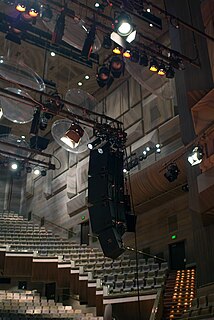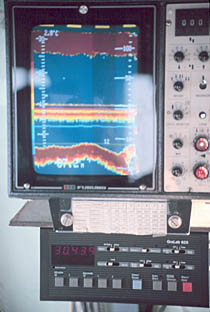
Acoustics is the branch of physics that deals with the study of all mechanical waves in gases, liquids, and solids including topics such as vibration, sound, ultrasound and infrasound. A scientist who works in the field of acoustics is an acoustician while someone working in the field of acoustics technology may be called an acoustical engineer. The application of acoustics is present in almost all aspects of modern society with the most obvious being the audio and noise control industries.

Sonar is a technique that uses sound propagation to navigate, communicate with or detect objects on or under the surface of the water, such as other vessels. Two types of technology share the name "sonar": passive sonar is essentially listening for the sound made by vessels; active sonar is emitting pulses of sounds and listening for echoes. Sonar may be used as a means of acoustic location and of measurement of the echo characteristics of "targets" in the water. Acoustic location in air was used before the introduction of radar. Sonar may also be used in air for robot navigation, and SODAR is used for atmospheric investigations. The term sonar is also used for the equipment used to generate and receive the sound. The acoustic frequencies used in sonar systems vary from very low (infrasonic) to extremely high (ultrasonic). The study of underwater sound is known as underwater acoustics or hydroacoustics.
A hydrophone is a microphone designed to be used underwater for recording or listening to underwater sound. Most hydrophones are based on a piezoelectric transducer that generates an electric potential when subjected to a pressure change, such as a sound wave. Some piezoelectric transducers can also serve as a sound projector, but not all have this capability, and some may be destroyed if used in such a manner.

Acoustical engineering is the branch of engineering dealing with sound and vibration. It is the application of acoustics, the science of sound and vibration, in technology. Acoustical engineers are typically concerned with the design, analysis and control of sound.

Bioacoustics is a cross-disciplinary science that combines biology and acoustics. Usually it refers to the investigation of sound production, dispersion and reception in animals. This involves neurophysiological and anatomical basis of sound production and detection, and relation of acoustic signals to the medium they disperse through. The findings provide clues about the evolution of acoustic mechanisms, and from that, the evolution of animals that employ them.

Hydroacoustics is the study and application of sound in water. Hydroacoustics, using sonar technology, is most commonly used for monitoring of underwater physical and biological characteristics.
Passive acoustics is the action of listening for sounds, often at specific frequencies or for purposes of specific analyses.

Ocean acoustic tomography is a technique used to measure temperatures and currents over large regions of the ocean. On ocean basin scales, this technique is also known as acoustic thermometry. The technique relies on precisely measuring the time it takes sound signals to travel between two instruments, one an acoustic source and one a receiver, separated by ranges of 100–5000 km. If the locations of the instruments are known precisely, the measurement of time-of-flight can be used to infer the speed of sound, averaged over the acoustic path. Changes in the speed of sound are primarily caused by changes in the temperature of the ocean, hence the measurement of the travel times is equivalent to a measurement of temperature. A 1 °C change in temperature corresponds to about 4 m/s change in sound speed. An oceanographic experiment employing tomography typically uses several source-receiver pairs in a moored array that measures an area of ocean.
A parametric array, in the field of acoustics, is a nonlinear transduction mechanism that generates narrow, nearly side lobe-free beams of low frequency sound, through the mixing and interaction of high frequency sound waves, effectively overcoming the diffraction limit associated with linear acoustics. The main side lobe-free beam of low frequency sound is created as a result of nonlinear mixing of two high frequency sound beams at their difference frequency. Parametric arrays can be formed in water, air, and earth materials/rock.
The ASA Silver Medal is an award presented by the Acoustical Society of America to individuals, without age limitation, for contributions to the advancement of science, engineering, or human welfare through the application of acoustic principles or through research accomplishments in acoustics. The medal is awarded in a number of categories depending on the technical committee responsible for making the nomination.
In acoustics, the sound speed gradient is the rate of change of the speed of sound with distance, for example with depth in the ocean, or height in the Earth's atmosphere. A sound speed gradient leads to refraction of sound wavefronts in the direction of lower sound speed, causing the sound rays to follow a curved path. The radius of curvature of the sound path is inversely proportional to the gradient.
Acoustic quieting is the process of making machinery quieter by damping vibrations to prevent them from reaching the observer. Machinery vibrates, causing sound waves in air, hydroacoustic waves in water, and mechanical stresses in solid matter. Quieting is achieved by absorbing the vibrational energy or minimizing the source of the vibration. It may also be redirected away from the observer.
The following outline is provided as an overview of and topical guide to acoustics:

USNS Hayes (T-AGOR-16/T-AG-195) was a Hayes-class oceanographic research ship acquired by the U.S. Navy in 1971. In 1992 she was reconfigured as an acoustics research ship and assigned to the Navy’s program of acoustic noise reduction for submarines.

Fisheries acoustics includes a range of research and practical application topics using acoustical devices as sensors in aquatic environments. Acoustical techniques can be applied to sensing aquatic animals, zooplankton, and physical and biological habitat characteristics.
ANSI/ASA S1.1-2013, published by the American National Standards Institute (ANSI), is the current American National Standard on Acoustical Terminology. ANSI S1.1 was first published in 1960 and has its roots in a 1942 standard published by the American Standards Association, the predecessor of ANSI. It includes the following sections
- Scope
- General
- Levels
- Oscillation, vibration, and shock
- Transmission and propagation
- Transducers and linear systems
- Acoustical apparatus and instruments
- Underwater acoustics
- Sonics and ultrasonic testing
- Architectural acoustics
- Physiological and psychological acoustics
- Musical acoustics
The Pioneers of Underwater Acoustics Medal is awarded by the Acoustical Society of America in recognition of "an outstanding contribution to the science of underwater acoustics, as evidenced by publication of research results in professional journals or by other accomplishments in the field". The award was named in honor of H. J. W. Fay, Reginald Fessenden, Harvey Hayes, G. W. Pierce, and Paul Langevin.
Transmission loss (TL) in general describes the accumulated decrease in intensity of a waveform energy as a wave propagates outwards from a source, or as it propagates through a certain area or through a certain type of structure.








